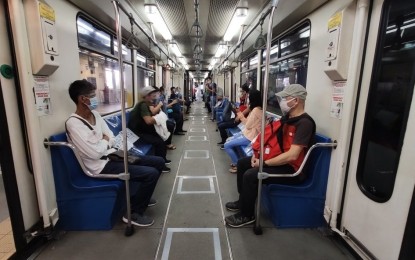
INSIDE MRT-3. Commuters keep safe distance between each other onboard the MRT-3 in this file photo. The government has allowed the physical distancing measure enforced inside public transport units at .75 meters between commuters starting Monday (Sept. 14, 2020). (File photo)
MANILA – The government’s decision to gradually reduce physical distancing among passengers in public transportation stays unless revoked by President Rodrigo Duterte, Malacañang said Wednesday.
Presidential Spokesperson Harry Roque made this remark after the Inter-Agency Task Force for the Management of Emerging Infectious Diseases (IATF-IED), in a six-hour meeting on Tuesday, reassessed the policy to relax physical distancing guidelines following opposition from medical groups.
“The body (IATF-EID) came up with a recommendation to be submitted to the President and it will be the President who will ultimately decide,” he said in an interview over CNN Philippines’ The Source.
Roque said the President will decide on the recommendation “no later than tomorrow.”
“It was previously approved in the last IATF meeting last Thursday so until the President revokes it, I think it will be implemented,” Roque said.
Roque, however, defended the decision of the task force to reduce physical distancing, saying the body’s decision is “based on science.”
He said former Health secretaries Manuel Dayrit and Esperanza Cabral even expressed support for the government’s move to reduce physical distancing on public transportation.
“I’d like to assure everyone over and over again that doctors were consulted and not all doctors share the view that it is only one-meter distancing that is the solution. There are very respected doctors including two former Secretaries of Health saying you can achieve containment of the disease by wearing masks, shields, disinfecting the public transportation, and more importantly prohibiting talking, prohibiting the use of cellphones,” he said.
Medical groups did not object to the directive when it was first approved by the IATF last Sept. 10, Roque added.
“When the IATF approved it, there was no objection, there was no controversy. The controversy came out again when medical groups after the decision was made, made an issue out of it,” he said.
He also emphasized that the government had to consider “all aspects” when making decisions, such as balancing health and the economy.
“It’s not as if one side wants to expose the population to the disease intentionally just for the sake of the economy. Because the reality is, even if you survive the disease if you can’t survive because you’re in poverty, that would not lead to any positive results,” he said.
On Monday, the government started implementing the directive to decrease physical distancing inside public utility vehicles to 0.75 meters from one meter, which is recommended by the World Health Organization (WHO).
The distancing would then be reduced to 0.5 meters (approximately 1.8 feet) on Sept. 28 and 0.3 meters starting October 12.
Medical experts opposed the move, warning that it could lead to an increase in coronavirus disease infections. (PNA)
